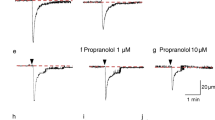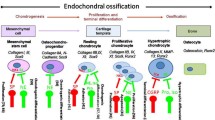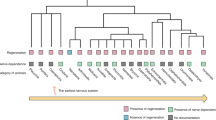Abstract
The periosteal arterioles of the compact bone may play a critical role in bone growth. To explore the contractile properties of tibial arterioles, spontaneous and nerve-evoked constrictions were compared in preparations from 3-week-old and 1-year-old guinea-pigs. Changes in arteriole diameters were measured using video microscopy. Their innervation was investigated using fluorescence immunohistochemistry. Fifty per cent and 40% of tibial arterioles from 3-week-old and 1-year-old guinea-pigs, respectively, exhibited spontaneous phasic constrictions that were inhibited by 1 μM nifedipine, 10 μM cyclopiazonic acid or 100 μM 2-APB. Nerve-evoked phasic constrictions in both age groups were largely suppressed by phentolamine (1 μM), an α-adrenoceptor antagonist, or sympathetic neurotransmitter depletion using guanethidine (10 μM) but were enhanced by spanttide (1 μM), a substance P receptor antagonist, or L-nitro arginine (L-NA; 100 μM), an inhibitor of nitric oxide synthase (NOS). Nerve-evoked constrictions in 1-year-old animals were smaller than those in younger animals but greatly enhanced by L-NA. Immunohistochemistry revealed sympathetic and substance P-positive primary afferent nerves running along the arterioles as well as endothelial NOS expression in both age groups. Spontaneous arteriolar constrictions appear to rely on both Ca2+ release from the sarcoplasmic reticulum and Ca2+ influx through L-type Ca2+ channels. Noradrenaline released from sympathetic nerves triggers arteriolar constriction, while substance P released from primary afferent nerves dilates the arterioles by releasing nitric oxide (NO), presumably from the endothelium. Thus, the enhanced endothelial NO release in adult guinea-pigs may be important to increase the blood supply to meet the increased metabolic demands during bone growth.








Similar content being viewed by others
Abbreviations
- 2-APB:
-
2-aminoethoxydiphenyl borate
- CPA:
-
Cyclopiazonic acid
- SP:
-
Substance P
- SR:
-
Sarcoplasmic reticulum
- TH:
-
Tyrosine hydroxylase
- NO:
-
Nitric oxide
- NOS:
-
Nitric oxide synthase
- α-SMA:
-
α-smooth muscle actin
References
Allen MR, Hock JM, Burr DB (2004) Periosteum: biology, regulation, and response to osteoporosis therapies. Bone 35:1003–1012
Boerman EM, Everhart JE, Segal SS (2016) Advanced age decreases local calcium signaling in endothelium of mouse mesenteric arteries in vivo. Am J Physiol Heart Circ Physiol 310:H1091–H1096
Brighton CT, Hunt RM (1997) Early histologic and ultrastructural changes in microvessels of periosteal callus. J Orthop Trauma 11:244–253
Bultynck G, Sienaert I, Parys J, Callewaert G, De Smedt H, Boens N, Dehaen W, Missiaen L (2003) Pharmacology of inositol trisphosphate receptors. Pflügers Arch - Eur J Physiol 445:629–642
Colantuoni A, Bertuglia S, Intaglietta M (1984) Quantitation of rhythmic diameter changes in arterial microcirculation. Am J Phys 246:H508–H517
Dinenno FAJM (2006) Alpha-adrenergic control of skeletal muscle circulation at rest and during exercise in aging humans. Microcirculation 13(4):329–341
Duda GN, Taylor WR, Winkler T, Matziolis G, Heller MO, Haas NP, Perka C, Schaser K-D (2008) Biomechanical, microvascular, and cellular factors promote muscle and bone regeneration. Exerc Sport Sci Rev 36:64–70
Fan W, Crawford R, Xiao Y (2008) Structural and cellular differences between metaphyseal and diaphyseal periosteum in different aged rats. Bone 42:81–89
Funk W, Endrich B, Messmer K, Intaglietta M (1983) Spontaneous arteriolar vasomotion as a determinant of peripheral vascular resistance. Int J Microcirc Clin Exp 2:11–25
García-Castellano JM, Díaz-Herrera P, Morcuende JA (2000) Is bone a target-tissue for the nervous system? New advances on the understanding of their interactions. Iowa Orthop J 20:49–58
Garland CJ, Dora K A (2016) EDH: endothelium-dependent hyperpolarization and microvascular signalling. Acta Physiol 1–10
Griffith TM (1996) Temporal chaos in the microcirculation. Cardiovasc Res 31:342–358
Hashitani H, Lang RJ (2016) Spontaneous activity in the microvasculature of visceral organs: role of pericytes and voltage-dependent Ca 2+ channels. J Physiol 594:555–565
Hashitani H, Mitsui R, Shimizu Y, Higashi R, Nakamura K (2012) Functional and morphological properties of pericytes in suburothelial venules of the mouse bladder. Br J Pharmacol 167:1723–1736
Hashitani H, Takano H, Fujita K, Mitsui R, Suzuki H (2011) Functional properties of suburothelial microvessels in the rat bladder. J Urol 185:2382–2391
Hill EL, Turner R, Elde R (1991) Effects of neonatal sympathectomy and capsaicin treatment on bone remodeling in rats. Neuroscience 44:747–755
Huang HH, Brennan TC, Muir MM, Mason RS (2009) Functional α1- and β2-adrenergic receptors in human osteoblasts. J Cell Physiol 220:267–275
Hurrell DJ (1937) The nerve supply of bone. J Anat 72:54–61
Hutmacher DW, Sittinger M (2003) Periosteal cells in bone tissue engineering. Tissue Eng 9(Suppl 1):S45–S64
Ian Mcnab D (1974) The role of periosteal blood supply in the healing of fractu...: clinical orthopaedics and related research. Clin Orthop Relat Res 27–34
Imai S, Matsusue Y (2002) Neuronal regulation of bone metabolism and anabolism: calcitonin gene-related peptide-, substance P-, and tyrosine hydroxylase-containing nerves and the bone. Microsc Res Tech 58:61–69
Iwaku F (1989) Microvasculature of bone II the three dimensional corrosion cast microvasculature on the outer surface of the rat’s parietal bone. J Bone Miner Metab 7:7–11
Jendzjowsky NG, DeLorey DS (2013) Short-term exercise training augments 2-adrenoreceptor-mediated sympathetic vasoconstriction in resting and contracting skeletal muscle. J Physiol 591:5221–5233
Kark T, Bagi Z, Lizanecz E, Pásztor ET, Erdei N, Czikora Á, Papp Z, Édes I, Pórszász R, Tóth A (2008) Tissue-specific regulation of microvascular diameter: opposite functional roles of neuronal and smooth muscle located vanilloid receptor-1. Mol Pharmacol 73:1405–1412
Lerner UH (2002) Neuropeptidergic regulation of bone resorption and bone formation. J Musculoskelet Neuronal Interact 2:440–447
Lundberg JM (1996) Pharmacology of cotransmission in the autonomic nervous system: integrative aspects on amines, neuropeptides, adenosine triphosphate, amino acids and nitric oxide. Pharmacol Rev 48:113–178
Mitsui R, Hashitani H (2013) Immunohistochemical characteristics of suburothelial microvasculature in the mouse bladder. Histochem Cell Biol 140:189–200
Mitsui R, Miyamoto S, Takano H, Hashitani H (2013) Properties of submucosal venules in the rat distal colon. Br J Pharmacol 170:968–977
Neild TO (1989) Measurement of arteriole diameter changes by analysis of television images. Blood Vessels 26:48–52
Offley SC, Guo T-Z, Wei T, Clark JD, Vogel H, Lindsey DP, Jacobs CR, Yao W, Lane NE, Kingery WS (2005) Capsaicin-sensitive sensory neurons contribute to the maintenance of trabecular bone integrity. J Bone Miner Res 20:257–267
Rackard SM, Carr AJ, Callanan JJ, Bellenger CR (2002) An avian model of limb deviation induced by periosteal surgery. Res Vet Sci 73:237–241
Ramasamy SK, Kusumbe AP, Schiller M, Zeuschner D, Bixel MG, Milia C, Gamrekelashvili J, Limbourg A, Medvinsky A, Santoro MM, Limbourg FP, Adams RH (2016) Blood flow controls bone vascular function and osteogenesis. Nat Commun 7:13601
Seals DR, Dinenno FA (2004) Collateral damage: cardiovascular consequences of chronic sympathetic activation with human aging. Am J Physiol Heart Circ Physiol 287:H1895–H1905
Starke K, Göthert M, Kilbinger H (1989) Modulation of neurotransmitter release by presynaptic autoreceptors. Physiol Rev 69:864–989
Suzuki A, Palmer G, Bonjour JP, Caverzasio J (1998) Catecholamines stimulate the proliferation and alkaline phosphatase activity of MC3T3-E1 osteoblast-like cells. Bone 23:197–203
Takeda S, Elefteriou F, Levasseur R, Liu X, Zhao L, Parker KL, Armstrong D, Ducy P, Karsenty G (2002) Leptin regulates bone formation via the sympathetic nervous system. Cell 111:305–317
Thomas GD, Sander M, Lau KS, Huang PL, Stull JT, Victor RG (1998) Impaired metabolic modulation of alpha-adrenergic vasoconstriction in dystrophin-deficient skeletal muscle. Proc Natl Acad Sci U S A 95:15090–15095
Yamano K, Ogata KSK (1984) Effects of sympathectomy on bone blood flow. Orthop Traumatol 32:249–251
Zygmunt PM, Petersson J, Andersson DA, Chuang H, Sørgård M, Di Marzo V, Julius D, Högestätt ED (1999) Vanilloid receptors on sensory nerves mediate the vasodilator action of anandamide. Nature 400:452–457
Acknowledgements
The authors wish to thank Dr. Richard Lang (Monash University) and Prof. Ikuo Wada (Nagoya City University) for their critical reading of the manuscript.
This study was supported by Grant-in-Aid for challenging Exploratory Research (No. 24659682 and No. 26670671) from Japan Society for Promotion of the Science (JSPS).
Author information
Authors and Affiliations
Corresponding author
Rights and permissions
About this article
Cite this article
Fukuta, H., Mitsui, R., Takano, H. et al. Contractile properties of periosteal arterioles in the guinea-pig tibia. Pflugers Arch - Eur J Physiol 469, 1203–1213 (2017). https://doi.org/10.1007/s00424-017-1980-4
Received:
Revised:
Accepted:
Published:
Issue Date:
DOI: https://doi.org/10.1007/s00424-017-1980-4




